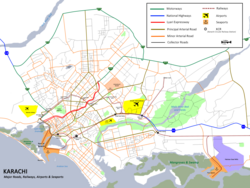| Revision as of 12:48, 4 August 2016 editAsarelah (talk | contribs)Autopatrolled, Extended confirmed users, Pending changes reviewers, Rollbackers70,459 editsNo edit summary← Previous edit | Revision as of 12:48, 7 October 2016 edit undoAsarelah (talk | contribs)Autopatrolled, Extended confirmed users, Pending changes reviewers, Rollbackers70,459 editsNo edit summaryNext edit → | ||
| Line 54: | Line 54: | ||
| ] | ] | ||
| ] | ] | ||
| ] | |||
Revision as of 12:48, 7 October 2016

Pir Mangho Urs (Template:Lang-ur) is an annual festival (urs) at the shrine of Sufi Pir Mangho at Karachi, Sindh, Pakistan. The urs marks the death anniversary of Pir Mangho and is held annually in the Islamic month of Dhu al-Hijjah. The Urs entirely separate from the more widely known Sheedi Mela that is also held at the Manghopir shrine.
Manghopir
Manghopir has some of the oldest Sufi shrines in Karachi where hot sulphur springs are believed to have curative powers and many crocodiles - believed locally to be the sacred disciples of Pir Mangho, roam freely. Balochs often call this place as 'Mangi' or Garm-aap / Sard-aap (due to the presence of the hot & cold springs).
Sheedis and festivals
Manghopir is mostly inhabited by one of Pakistan's smallest ethnic communities, Makrani or Sheedi. Sheedi are said to be the descendants of Afro-Arabs from Zanzibar and maintain their distinct Afro-Arab and Omani identity in the midst of the dominating South Asian cultures.
Presently, these African-Pakistanis live in various parts of Karachi. Most are found in Lyari, but they are also found in Malir, Moaach Goth, Manghopir, and further interior at Sindh and Balochistan. Due to Lyari's dominant Sheedi people population, it is often called 'Little Africa'. Some Afro-Arab style festivals and dances like Gowaati, Lewa, Dhamaal, beating Omani style shindo, jabwah, and jasser drums are still popular in Manghopirs Lyari locale. Many forms of folk beliefs and medicines are also still practiced. A prominent Urdu poet and Lyari citizen, Noon Meem Danish, proudly claims to be the great-great-grandchild of an African from Zanzibar. "Now after centuries of cultural amalgamation, Sheedis proudly call themselves Baloch or Makrani."
Crocodiles
The crocodiles are an integral part of the shrine and are so tightly interwoven with the story of the saint that it is almost impossible to judge between fact & fiction. There are many traditions about myth of crocodiles, as if it is believed that Baba Farid gave the reptiles to Manghopir. According to scientific explanations, these crocodiles were carried through some heavy floods, during ancient times and later gathered or collected at this pond. Archaeological investigations have also suggested the existence of a Bronze Age settlement (2500-1700 BC) near Manghopir, who worshipped crocodiles and before the advent of Islam crocodiles were also thought sacred for Hindus.
Hot springs and healing resort
There are hot and cold springs about a kilometer from the shrine. Warm water passing through the sulphur rocks is said to have some medicinal qualities. Many people with skin diseases regularly come from long distances to have a bath to cure them. There are separate swimming pools and shower rooms for men and women. Scientific analysis has shown that this warm water is naturally saturated with carbon dioxide, besides containing some sulphur & other skin friendly nourishments, which are no doubt suitable for many skin-diseased patients.
See also
- Islam Pir
- Urs
- Pir Mangho
- Manghopir
- Manghopir Hills
- Makrani
- Sheedi
- Sheedi Mela
- Abdullah Shah Ghazi
- Ayub Shah Bukhari
External links
References